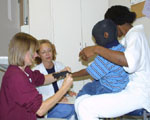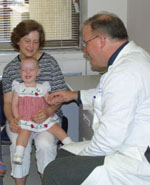Medical Center offers pediatric burn services
by Heather MurphyPublic Relations
Arms swing and heads bob as three children parade down the third floor hallway of Rutledge Tower. Though minus the fancy costumes and beating drums, the participants couldn’t be having more fun.
Led by Betsy McCutcheon, Child Life specialist, this parade’s only goal was to get a little girl with burned legs to bend her knees.
 Jill
Evans, center, observes Amy Ferguson, an MUSC physical therapist, as she
places compression gloves back on Careme Hamilton's hand.
Jill
Evans, center, observes Amy Ferguson, an MUSC physical therapist, as she
places compression gloves back on Careme Hamilton's hand.
MUSC’s pediatric burn services takes a multidisciplinary approach to patient care. Each child receives attention from three attending physicians, a burn nurse specialist, a burn care tech, a child life therapist, a pharmacist, a nutritionist, and occupational and physical therapists. Sometimes a social worker, a psychiatrist or critical care staff members may be involved.
The service is actually a division of pediatric surgery, headed by Edward Tagge, M.D. Although the adult burn unit has been closed since June, the pediatric burn service still accepts all burned children 17 and under and is the pediatric burn referral center for South Carolina.
 Sara
Kenny, 18 months, giggles as Dr. Edward Tagge begins to examine her healing
hand. Mom, Laura Kenny, smiles at the sight of her daughter finally at
ease.
Sara
Kenny, 18 months, giggles as Dr. Edward Tagge begins to examine her healing
hand. Mom, Laura Kenny, smiles at the sight of her daughter finally at
ease.
“This burn service is special because of a holistic approach to developmental, social and pain issues,” Tagge said, “The combination of a top 10 children’s hospital and one of 10 pediatric burn units run by pediatric surgeons is hard to come by. There are very few units that have expertise in pediatric burns and surgery at the same time.”
“The designated team will follow the patient wherever he or she may go,” said Jill Evans, pediatric burn services coordinator, “Children’s needs are unique from adults and must be met throughout their stay. Everyone who works here specializes in children and the integrated approach allows for all types of therapy.”
Bill Adamson, M.D., head of the pediatric burn team, echoes Evans, “Our team of professionals follows a patient throughout the Children’s Hospital, and that continuity of care is what differentiates us from other services.” Indeed, outpatients and inpatients alike are familiar with at least three people in the room to examine their progress.
The pediatric burn service receives 80 to 100 inpatients per year and about 400 clinic visits a year. But outpatient treatment is more than office visits.
Members of the burn team travels to a patient’s school and educates classmates about burns and how to accept the student’s new look. The staff organizes and runs Camp Can Do every summer for burn victims who are currently receiving treatment and even those that received treatment up to 10 years before.
“It’s important to remember that you aren’t just treating the child after the initial incident but you continue to treat the child for months and even years. You’re also treating the child’s family,” said Evans.
“Another added benefit of our team is the fact that we are a teaching university,” said Tagge. “Having residents on the team helps provide additional layers of care for inpatients and outpatients. Because of the coordination with the pediatric surgeons and pediatric intensivists from the ICU team, a patient has six doctors dealing with his or her problem instead of one.”
And it’s not just doctors involved with these patients. Child Life therapists, like McCutcheon, involve the children in play therapy and interact with them in places like the Atrium in the Children’s Hospital.
“Kids don’t like to be confined and the way that our program is set up throughout the hospital, they don’t have to be,” said Tagge.
“We try to avoid the stigma of the ‘big, bad, ugly burn center’ and instead be ‘the burn center without walls’,” said Evans.
Another unique aspect of MUSC’s pediatric burn service is the source of some of the funding for the unit. Aluminum Cans for Burned Children (ACBC) is a special aluminum can recycling program conducted by approximately 300 fire departments and businesses throughout South Carolina.
The money earned through the program pays for non-medical items for burned children, like bandages, ointments, rehabilitation equipment, bicycles, family meals and lodging. This fiscal year, the program has taken in about $90,000.
“We do everything with the best interest of the children in mind,” said Mary Wiltshire, director of ACBC, “Every case is different so they all require different things. We’ve paid for car repairs so that victims can make it to clinic appointments. Once we paid more than $2,000 to Comfort Inn so that the mother of a burn victim could stay in town during the Christmas holiday.”
Wiltshire says that it’s vital to make the recovery process as easy as possible. “These kids go through hell and so do their families. I can’t imagine my child going through it.”
Speaking of funds, a recent focus of the pediatric burn unit involves reducing costs that the families of burn victims must endure. The intensive outpatient system helps with this and on average, each child stays one day for each percentage of burn.
Because of its holistic, multidisci-plinary approach and commitment
to the specialized care of children, the pediatric burn service will continue
to be a staple at the Medical University.
Catalyst Online is published weekly, updated as
needed and improved from time to time by the MUSC Office of Public Relations
for the faculty, employees and students of the Medical University of South
Carolina. Catalyst Online editor, Kim Draughn, can be reached at 792-4107
or by email, catalyst@musc.edu. Editorial copy can be submitted to Catalyst
Online and to The Catalyst in print by fax, 792-6723, or by email to petersnd@musc.edu
or catalyst@musc.edu. To place an ad in The Catalyst hardcopy, call Community
Press at 849-1778.